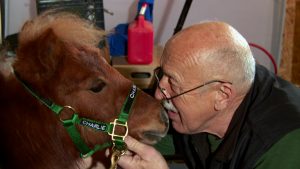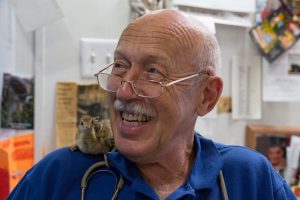If he had been a giant, broad-shouldered 12-year-old, the Incredible Dr. Pol may never have found a calling as a veterinarian.
The youngest of six children, Dr. Jan Pol was raised on a dairy farm in the Netherlands and had aspired to become a farmer when he grew up, but land was scarce in the country at the time. That career goal changed one day when a local veterinarian picked up 12-year-old Pol to help deliver piglets at his brother’s place.
“I was tall and skinny, and he was a typical large animal veterinarian with huge shoulders and arms, and he knew I could get in a lot farther than he could. So here I am laying behind those pigs in the straw up to my shoulder looking for little pigs inside, and I thought it was a lot of fun to get those things out squealing,” Pol said. “From that time on, I said yep, ‘I might as well become a veterinarian if I can’t become a farmer.’”
A veterinarian for 47 years, Pol has built quite the practice in Weidman, Michigan, with 23,000 clients, and patients ranging from white mice and snakes to cows and 2,600 pound horses — and everything in between. He is also the international star of the Nat Geo WILD’s No. 1 hit series, “The Incredible Dr. Pol,” as well as author of the best-selling book, “Never Turn Your Back on an Angus Cow: My Life as a Country Vet.”
Pol credits his son Charles for his global notoriety. Infatuated with movies since he was a preschooler, Charles wanted to either make movies or be a producer of reality shows. After graduating from film school in Miami, Pol’s son tried to get his foot in the door in Los Angeles.
The pitch that worked? A show about his dad, a large animal veterinarian in the middle of Michigan. In 2010, Charles, two friends and a cameraman showed up at Pol’s practice and followed him around for one week, capturing 27 hours of filming to make a four-minute DVD to show the networks. Nat Geo WILD was hooked.
Today, the film crew spends 100 hours a week taping Pol to produce the popular 40-minute show. Next March, the network expects to reach the 100th episode of “The Incredible Dr. Pol,” a feat that no other show has accomplished on Nat Geo WILD. And nothing on the show is scripted.

“What you see when we work with animals is what we do,” Pol said. “Nothing is done for the camera.”
For Pol, the show is another way to share his beloved profession with the world.
“My calling is to help animals, and I’ve tried to do it to best of my knowledge and my abilities. And sometimes it can be a little hard, but other times it can be very rewarding when things go well,” said Pol.
The vet gives an example from two summers ago, when a farmer had a cow trying to calf, and it was over 100 degrees in the barn. The bull calf was stubborn and upside down, but it was alive.
“I wanted to get that sucker out alive, and it was work. Yeah I had the sweat in my boots, in my shoes but I got the calf out alive finally,” Pol said. “Then when you are done like this and it’s on the ground and it’s breathing, and everyone is looking at you and everybody is dirty and everybody is sweating like a horse, you say, ‘Hey it’s all well worth it.’”
There are also days when the job is tough. One of those times was when a mother and daughter brought their 27-year-old cat into the clinic to be put down. Another was featured in the final episode from last season when Pol had to put his own Great Dane down due to bone cancer. She was almost 10 years old.
“Those days are hard. Because I have pets of my own like that, when somebody comes to the clinic with a dog that they have had for that number of years or even longer, it is just as hard,” Pol said. “I went to school to help animals, not to put them down, but it is part of the job.”
That job not only involves taking care of pets and pulling calves, it also includes making a diagnosis on some exotic species.

“When we went to school in the Netherlands we were taught what a normal animal looks like. We have five senses — we see, we listen, we feel, we smell, and we taste — the taste comes dead last … believe me … sometimes that is by accident,” Pol joked. “Those four senses — use them and that will tell you already a lot of what is wrong with the animal. You listen to the owner, you look at the animal, you feel them over and sometimes you smell, honestly. Those things are very important to come to a tentative diagnosis.”
Pol said many vets today learn to test first and make a diagnosis afterward — that is backward to him. He also said he often uses books as a reference.
For example, two women who rescue older pot-belly pigs came into his clinic recently. They had three pigs — 80, 60, and 40 pounds, two females and one male — and they wanted to get them fixed so they would behave a bit better. They couldn’t find a local vet to do it as all of the other practices would only offer the procedure to pot-belly pigs under five pounds.
Pol knew someone had given anesthetics to pigs this size before so he looked up the answers and the ladies drove their pigs 150 miles to his clinic for the procedures.
“This is my calling. These people needed help,” Pol said “Veterinary medicine is a service-related business. You do a service on the animal to help the people take care of them.”
That service is now recognized around the world. Pol and his wife, Diane, cannot walk any place in the U.S., or the Netherlands, without people recognizing them. When they attended a recent veterinary conference this year, his colleagues were also supportive.
“Everybody is very positive because the show is about animals and the people who are watching are animal lovers,” Pol said. “Here’s what I said many times: ‘The people who love animals are good people.’”
They have received letters from all over the U.S., Australia, South Africa, Indonesia, Turkey, Spain, France, Germany, and of course the Netherlands. Recently Pol and his wife received a package from California, with a picture of his Great Dane he had to put down. The photo was taken off the TV and framed; the letter enclosed had many mistakes and poor grammar. The fan wrote: “Forgive me about my spelling and my grammar because I have had a stroke. I don’t remember everything from day to day, but I love your show.”
“When you get a letter like this, words are not enough,” Pol said.
The Pols have enjoyed visitors from age 1 ½ to 96 at their clinic. Children are the vet’s biggest fans.
When Pol pulls a calf or another animal and it’s a little bit stressed or not breathing well, he often takes a pail of cold water and dumps it over them. It cuts the mucous and wakes the newborn up.
He recently received a letter from a sheep farmer in Oregon who said his 8-year-old daughter had saved about 20 lambs last spring, trying out Pol’s method … whenever a lamb had to be pulled, there she was standing there with a bucket of cold water
“You don’t know how may children are watching the show,” Pol said. “You can’t fool a kid, and I think they see the reality of the show.”
Pol and his wife attended the National FFA Convention in Indianapolis in October. On that Thursday from 8 a.m. to 5 p.m., they visited with thousands of students and teachers and only took two 15-minute breaks. When the show ended for the day, there were still 50 fans in line.
Teachers are now using “The Incredible Dr. Pol” show to teach large animal medicine to FFA kids, because access to farms and dairies is often very limited or nearly impossible. With the shortage in large animal veterinarians nationwide, Pol’s show might be one way to inspire students to consider the career.
“The education in large animal is almost negligible because they don’t have the exposure to the animals coming to the clinic,” Pol said. “Many have to pick it up during internships after they graduate if they want to.”
Despite a little arthritis in his leg, Pol doesn’t have any plans for retirement. Besides his practice, his work with animal control in six counties keeps him very busy, and it’s often a job that other vets aren’t willing to do … but that’s what essentially sets Pol apart.
“The common-sense approach that we have, and what I do, is what people are looking for,” Pol said. “As long as I can do my work and enjoy it, I think it’s worth it.”
A new season of “The Incredible Dr. Pol” premieres on Saturday, Jan. 7 at 9/8c and marks the beginning of the countdown to the series’ 100th episode, which airs as this season’s finale in March.



